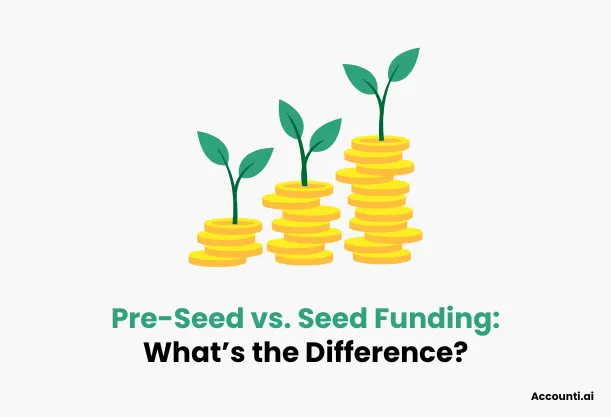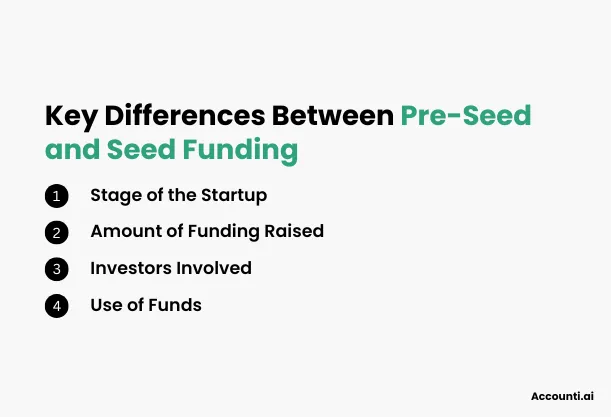
Pre-Seed Funding vs. Seed Funding: What’s The Difference?
Starting a business can feel like a journey into the unknown. You're fueled by passion and ideas, but often the path forward is marked by uncertainty—especially when it comes to funding. For budding entrepreneurs, understanding the different stages of funding is crucial. Two of the earliest stages are pre-seed funding and seed funding, and while they may sound similar, they serve distinct purposes.
In this article, we’ll break down the differences between pre-seed and seed funding, explain their importance, and help you navigate this exciting phase of your startup’s journey. Let’s get into it!
What is Pre-Seed Funding?
Pre-seed funding is often called the "friends and family round" of fundraising. It’s the earliest stage of funding that a startup might pursue, and it typically happens before your business even takes its first big steps.
Pre-seed funding is the initial capital raised by founders to kickstart their business. At this stage, the business idea might still be in its infancy. You’re likely working on building a prototype, conducting market research, or even refining your concept.
- Stage: Idea to early validation.
- Amount Raised: Usually between $10,000 and $250,000.
- Focus: Proving feasibility.
Typical Sources of Pre-Seed Funding
At this stage, you're not likely to see institutional investors. Pre-seed funding often comes from:
- Personal savings: Founders investing their own money.
- Friends and family: Those closest to you who believe in your vision.
- Angel investors: Wealthy individuals looking to invest in high-potential startups.
- Startup accelerators: Programs offering mentorship and small investments.
Purpose of Pre-Seed Funding
Pre-seed funding allows you to:
- Test your idea and validate it in the market.
- Build a minimum viable product (MVP).
- Cover initial operational costs like office space, basic marketing, or legal fees.
Essentially, it’s all about turning your idea into something tangible.
What is Seed Funding?
Seed funding, often called the "first official money" a business raises, comes after you’ve laid some groundwork. By this point, your startup has evolved from a raw idea into a budding business.
Seed funding is raised to help startups develop their product, grow their team, and enter the market. It’s the stage where you shift gears from validation to execution.
- Stage: Early growth.
- Amount Raised: Typically between $100,000 and $2 million (but can go higher for high-growth startups).
- Focus: Scaling the business.
Typical Sources of Seed Funding
Unlike pre-seed funding, seed funding attracts more serious investors:
- Venture capital firms (VCs): Smaller VC firms or funds specifically targeting early-stage startups.
- Angel investors: Individuals who continue to back startups with high growth potential.
- Crowdfunding platforms: Platforms like Kickstarter or Indiegogo can help raise money from the public.
- Corporate investors: Large companies that invest in startups aligned with their strategic goals.
Purpose of Seed Funding
Seed funding is designed to:
- Build out your team (developers, marketers, sales, etc.).
- Refine your product based on user feedback.
- Execute a go-to-market strategy.
- Scale operations to attract more customers and additional investors.
At this stage, you’re no longer just proving your idea—you’re proving that your business can grow.
Key Differences Between Pre-Seed and Seed Funding
Understanding the differences between these funding stages can help you determine what’s right for your startup. Let’s explore some of the major distinctions.

1. Stage of the Startup
- Pre-Seed: Your startup is still in the ideation or validation phase. You’re testing whether your idea can even work.
- Seed: Your startup has some traction and is looking to scale. You’re focusing on growth and market expansion.
2. Amount of Funding Raised
- Pre-Seed: The amounts are smaller, ranging from $10,000 to $250,000. The focus is on basic validation.
- Seed: Funding is more substantial, usually between $100,000 and $2 million, meant for scaling and execution.
3. Investors Involved
- Pre-Seed: Investments come from friends, family, angels, and sometimes startup accelerators.
- Seed: You’ll see more formal investors, including venture capital firms, angel syndicates, and corporate funds.
4. Use of Funds
- Pre-Seed: The money is often used to build an MVP, conduct market research, or create a pitch for larger investors.
- Seed: Funds are used to refine the product, hire team members, and build a customer base.
Comparison Table
|
Aspect |
Pre-Seed Funding |
Seed Funding |
|
Stage |
Idea/Validation |
Early Growth |
|
Amount Raised |
$10,000 - $250,000 |
$100,000 - $2 million |
|
Investors |
Friends, family, angels |
VCs, angel syndicates, corporates |
|
Purpose |
MVP development, validation |
Scaling, market entry |
|
Risk Level |
High (concept stage) |
Medium (some proof of concept) |
Why Understanding These Stages Matters
The distinction between pre-seed and seed funding isn’t just about timing—it’s about aligning your funding efforts with your startup’s financial health and strategic goals. For instance, while pre-seed funding might focus on creating a minimum viable product (MVP) or testing an idea, seed funding gears toward scaling and revenue generation.
But here’s the catch: as you scale, it’s crucial to keep an eye on your profit margins to ensure long-term sustainability. A good profit margin for a startup can act as a key indicator of whether your business is financially healthy and ready for additional investment. Understanding your margins early on can give you leverage when pitching to investors, especially during the seed stage.
The distinction between pre-seed and seed funding isn’t just semantics—it has real-world implications for how you approach your business.
1. Tailored Pitching
Investors at each stage expect different things. Pre-seed investors are more likely to bet on your vision and potential, while seed investors want to see some traction or proof of success.
2. Better Use of Resources
Knowing where you stand ensures that you’re not raising more money than you need or spending funds inefficiently. Pre-seed funding is for testing and building, while seed funding is for growth and execution.
3. Long-Term Strategy
Understanding these stages helps you map out a funding strategy. By the time you move to seed funding, you should have a clear roadmap for how you’ll use the money to generate returns.
Conclusion
Funding is the lifeblood of startups, and understanding the nuances between pre-seed funding and seed funding can set you up for success. While pre-seed funding focuses on validating your idea and building the basics, seed funding is about scaling and growing your business.
By knowing where your startup stands and what each funding stage requires, you can approach investors with confidence and clarity. Remember, each dollar you raise is a step closer to turning your vision into reality!
FAQs
How does pre-seed funding work?
Pre-seed funding is the earliest stage of startup financing, aimed at transforming a concept into a viable business. At this juncture, startups often lack a fully developed product or significant market presence. Funding typically comes from personal savings, friends and family, angel investors, or startup accelerators. The capital is primarily used for product development, market research, and building a foundational team. Investments at this stage are frequently structured using convertible instruments like SAFEs (Simple Agreements for Future Equity) or convertible notes, which convert into equity during subsequent funding rounds.
What are the disadvantages of pre-seed funding?
While pre-seed funding provides essential early capital, it comes with certain drawbacks:
- Equity Dilution: Early-stage investments often require giving up a significant equity stake, which can impact future control and ownership.
- Signaling Risk: Securing funds from prominent investors can be a double-edged sword. If these investors don't participate in future rounds, it may send negative signals to other potential investors.
- Investor Management: Managing relationships with early investors can be complex, especially when balancing differing expectations and involvement levels.
How long does it take to raise pre-seed funding?
The timeline for raising pre-seed funding varies based on factors like the startup's industry, network strength, and market conditions. On average, it can take several months to secure pre-seed capital. Founders should allocate ample time for preparation, pitching, due diligence, and negotiations. Building relationships with potential investors early can help expedite the process.
How much equity do pre-seed investors typically take?
Pre-seed investors often seek equity stakes ranging from 5% to 20%, depending on the startup's valuation, perceived risk, and investment amount. Given the higher risks at this stage, investors may negotiate for a larger share. However, founders should carefully consider the long-term implications of equity dilution on control and future fundraising.
How should founders approach investors for pre-seed funding?
Approaching investors for pre-seed funding requires strategic planning:
- Develop a Compelling Pitch: Clearly articulate your vision, market opportunity, business model, and team strengths.
- Build a Minimum Viable Product (MVP): Having a tangible prototype or MVP can significantly enhance credibility and attract investor interest.
- Leverage Networks: Utilize personal and professional networks to secure warm introductions to potential investors.
- Research Potential Investors: Identify investors who focus on your industry and have a history of pre-seed investments.
- Demonstrate Market Understanding: Showcase thorough market research and a clear strategy for addressing your target audience's needs.
- Be Prepared for Due Diligence: Maintain organized documentation of your business plan, financial projections, and legal matters to facilitate the due diligence process.
By meticulously preparing and targeting the right investors, founders can enhance their chances of securing pre-seed funding.

 Rohit Kapoor
Rohit Kapoor

